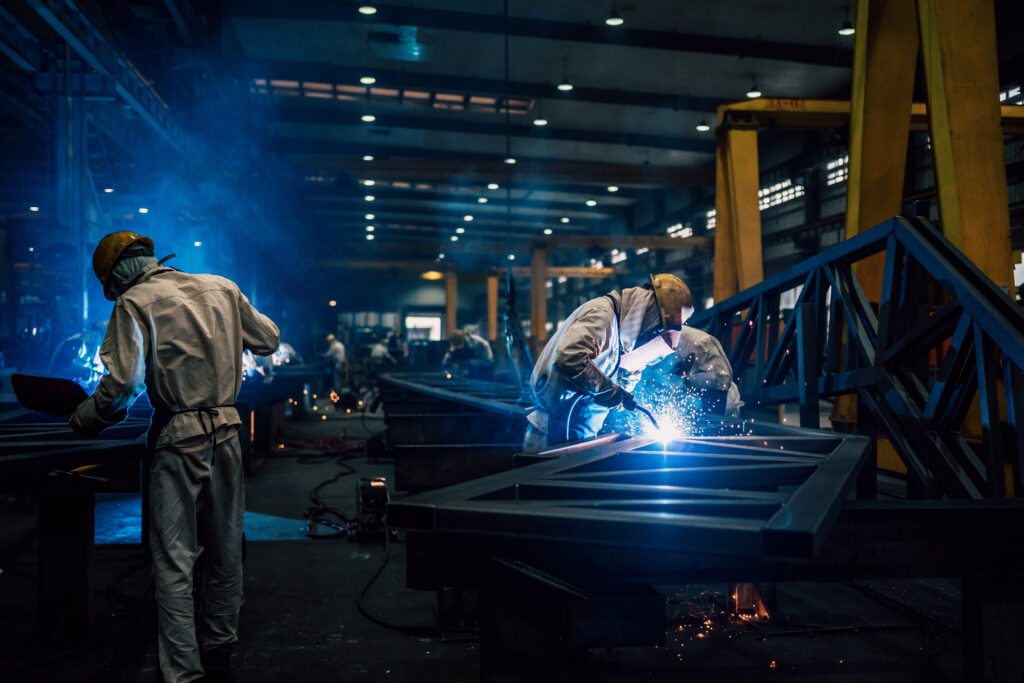Welder Working Conditions
What are the working conditions like for welders?
Within the multifaceted welding industry, there are seemingly endless paths to become a welder, each with unique responsibilities and working conditions. Read on to learn about where and how welders work and see if this may be a field of interest to you.
Explore the typical working conditions for welding professionals
Welders operate in a variety of working environments. Below, we’ll take a closer look at the working conditions for some of the most common welding careers.

Indoors
Seemingly some of the most straight-forward welding takes place indoors, and includes such paths as aerospace, automotive, manufacturing, and industrial welding.
While not faced with the same volatility of outdoors and underwater welding, those performing their welds indoors must still contend with loud noises, potentially hazardous fumes, bright lights, and high heat produced by the welding process. These professions typically work within tight spaces with proper ventilation and safety measures designed to keep glare and sparks under control.
Outdoors
Military Support Welding
To begin welding for military-specific projects, welders must first join the Armed Forces, by completing basic training.
Once completed, they can be stationed in domestic bases or international facilities, servicing weapons, vehicles, and other military assets. It is important to note that military welders may be called upon to perform their duties in conflict zones.
Watercraft Welding
Those looking to get their feet wet may find their calling in onboard ship maintenance. These welding professionals may take up a post aboard cruise and passenger ships to monitor and maintain their vessels while at sea. This role comes with added risk, but offers professionals an opportunity to see the world.
Others can still purse a career in watercraft welding by becoming a shipyard welder. These professionals typically work in commercial or military shipyards and may be called upon to travel between various ports across the globe. A day in the life includes the repair, maintenance, and assembly of a variety of watercraft including cargo ships, utility vessels, and personal watercrafts.
Structural/Construction Welding
Due to strict construction schedules and process, structural workers typically work rain or shine. This can be challenging considering most of their welds are performed outdoors and can include locations like bridges, freeways, tunnels, and sometimes even hundreds of feet in the air atop a scaffold or suspended from a skyscraper.
However, as with every form of welding, safety is essential to this job, therefore work is usually paused during extreme weather.
Rig Welding
With positions available both onshore and offshore, the working conditions for these professionals may vary. This is underscored by the fact that for offshore workers, some of the structural components that they are expected to maintain are found underwater.
Regardless of the location however, most rig workers are expected to be available around the clock and will typically live on-site for extended periods of time.
Pipeline
Offering perhaps some of the most diverse working conditions, pipeline welding can be performed anywhere from buildings, sewers, oil rigs, and power plants. Those roles can take place in extreme temperature conditions running the gamut from subzero temperatures to the extreme heat of desert environments.
A common path for these workers is sewer pipeline welding, which can expose workers to hazardous and unpleasant material if proper measures are not taken.
Underwater
Underwater Welding
Perhaps one of the most specialized and potentially dangerous welding career paths, underwater welding requires an additional set of skills and disciplines including dive training and a rigorous physical examination.
As an underwater welder, you may find yourself working in inland bodies of waters such as lakes and rivers, or offshore in deep-sea, high-water pressure conditions. These conditions bring added complications such as extreme temperature drops in deep sea waters, and reduction of visibility due to dim lighting, murky waters, or air bubbles.
Pipeline Welding
Those who branch into underwater pipeline welding will typically work in dry chambers which are pressurized, water-tight environments that can house up to three welders. These dry chambers are designed to minimize pressure sickness.
Common challenges of a career in welding
While there are unique risks involved with each type of welding career, due to the nature of the trade and the equipment welders rely on, there are several common risks all welders should be aware of. Learn more about those risks, and the safety measures needed to mitigate them, here.
Kickstart a career in welding with ResourceMFG
With the American Welding Society reporting that more than 155,000 welders are approaching retirement amid field growth, there’s a projected shortage of 90,000 welding workers annually between 2023 and 2027. That means welders are in demand across industries, and with strong job prospects, competitive wages, and opportunities for professional growth, now is a great time to start a career in welding.
ResourceMFG is a trusted partner, helping skilled professionals foster thriving careers in welding and beyond. Ready to start on your path to a rewarding welding career? Explore all of our career opportunities or contact your local branch to learn more about how we can support you.